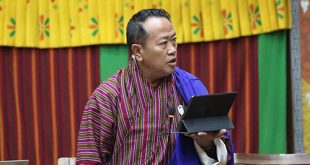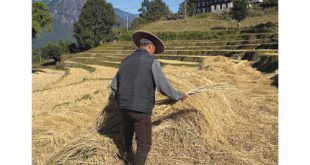 A dearth in human resources has always been an issue for health ministry but with the launch of Bachelors of Science in Nursing and Midwifery program it is expected to improve quality and increase quantity of nurses.
A dearth in human resources has always been an issue for health ministry but with the launch of Bachelors of Science in Nursing and Midwifery program it is expected to improve quality and increase quantity of nurses.
Nurses and Midwives account for a large prtion in health workforce in many countries including Bhutan.
“Today, 90% of our faculty have a Master’s degree in Nursing, Midwifery and Public Health,” said the Director of RIHS Chencho Dorjee adding that the course not only developed leaders in nursing and improved the quality of care but helped build institutional capacity to start bachelors program of our own.
Till date RIHS has trained 483 general midwives and 211 auxiliary nursing midwives and 173 assistant nurses beside a large number of other categories of health workforce.
The health ministry successfully conducted three batches of upgradation for in-service nurses with La Trobe University of Australia.
At present, RIHS provides pre-service courses as well as in-service courses namely bachelors in public health, the Bhutan Health Worker (BHW) up gradation and nursing and midwifery program.
The four year Bachelors of Science in Nursing and Midwifery program will start in July 2013.
“The course is introduced to promote healthy competition among students and to inspire nurses in the field to upgrade their qualification and sustain their motivation,” Director Chencho Dorjee said.
Health minister Zangley Dukpa said success of any health system to a large extent depends on its health workforce. “Unfortunately throughout the world there are critical shortages of health workforce particularly in developing countries”.
The global deficiency is estimated around 2.3mn physicians, nurses and midwives and all over 4mn health workers.”
Despite consistent efforts from the health ministry and RIHS, population ratio of nurses stand at only four nurses per 10,000 population, which is far below the WHO prescribed ratio.
This shortage, the health minister said, had worsened with an increased life-expectancy and growing incidence of non-communicable diseases, rapidly growing health-care needs and mounting contemporary public health challenges.
He said this calls for strengthening of human resources for health both in number and quality.
The recent World Health Assembly on Nursing and Midwifery mandates WHO to strengthen the nursing and midwifery capacity in all member countries. It is testament and testimony to the growing recognition of the nursing and midwifery profession by all member countries.
The launch of bachelors in nursing and midwifery is noted as timely with RIHS soon to be upgraded to the faculty of nursing under University of Medical Sciences of Bhutan (UMSB) which will be launched later this year.
Regional Director of South East Asia Region, WHO Dr. Samlee Pliangbangchang said it is known that more professional nurses and midwifery is needed in Bhutan.
“The number needed is at least 2,100 to be self-reliant in production of nurse midwives,” said the WHO regional director.
He said that the country needs nurse midwives who are able to manage health conditions in a holistic and systematic manner, manage health facilities efficiently and can apply evidence-based information.
About 140 new students joined the program which increased the total to 350 while 23 senior nurses are already undergoing the two year upgradation course.
 The Bhutanese Leading the way.
The Bhutanese Leading the way.




what an information to the readers…..BHW is Basic Health Worker not Bhutan Health Worker as mentioned by reporter…..it is such a simple term widely used in Bhutan…how reliable can the paper be when such simple term can be mistaken…..